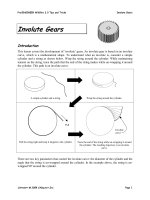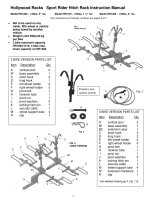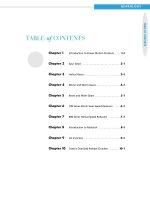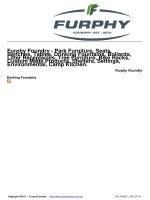HELICAL GEARS INTERNAL GEARS RACKS CP RACKS PINIONS MITER GEARS BEVEL GEARS SCREW GEARS WORM GEARS GEARBOXES SPUR GEARS OTHER PRODUCTS
Bạn đang xem bản rút gọn của tài liệu. Xem và tải ngay bản đầy đủ của tài liệu tại đây (2.19 MB, 21 trang )
<span class="text_page_counter">Trang 1</span><div class="page_container" data-page="1">
When using the injection molded bevel gear as an idler gear and a shaft diameter smaller than the inside diameter of the molded gear, please press fit one of the following standard bushings.
<i><b>Sintered Metal Bushings</b></i>
Product Precautions Page 306
<b>Bevel Gears</b>
Catalog Number of KHK Stock Gears
The Catalog Number for KHK stock gears is based on the simple formula listed below. Please order KHK gears by specifying the Catalog Numbers.
S S45C B Straight Bevel Gears M SCM415 BS Spiral Bevel Gears SU Stainless Steel HP High-Ratio Hypoid Gears
Direction of Helix (Right) No. of teeth of mating gears (20) No. of Teeth (40)
Module (2)
Other Products (Ground Gears) Type (Spiral Bevel Gears) Material (SCM415) <small>MHP</small>
<small>Gear Ratio 15~60Gear Ratio 2Gear Ratio 1.5~3Gear Ratio 1.5~3Gear Ratio 1.5~4Gear Ratio 1.5~4Gear Ratio 2~4</small>
<small>Material: SCM415Material: SCM415Material: S45CMaterial: SCM415Material: S45CMaterial: S45CMaterial: S45C</small>
<b><small>m1, 1.5 Page 342m2~4 Page 346m2~4 Page 348m2~6 Page 350m1~5 Page 354m1~6 Page 358m5~8 Page 358</small></b>
<small>Gear Ratio 5Gear Ratio 1.5~3Gear Ratio 1.5~3Gear Ratio 2Gear Ratio 1~2</small>
<small>Material: S45CMaterial: SUS303Material: MC901Material: Duracon (R) (M90-44)Material: Oil-free copper alloyMaterial: SCM415</small>
<b><small>m1.5~3 Page 362m1.5~3 Page 364m1~3 Page 366m0.5~1 Page 368φ5~6 Page 368m1.5~6 Page 370</small></b>
</div><span class="text_page_counter">Trang 2</span><div class="page_container" data-page="2">KHK stock bevel gears are available in two types, spiral bevel gears and straight bevel gears, in gear ratios of 1.5 through 5, and are offered in a large variety of modules, numbers of teeth, materials and styles. The following table lists the main features for easy selection.
Type <sup>Catalog Number Module Gear Ratio Material</sup>
<b>MBSG</b>
2~4 2 SCM415 <sup>Carburized </sup><sub>Note 1</sub> Ground 1 △ <sup>Gears that have been hardened and ground that has </sup>excellent accuracy, strength and abrasion resistance. Secondary operations are possible except for the teeth.Gear teeth induction hardened
Ground 2 △ <sup>Gears that has been hardened and ground with a </sup>good balance of accuracy, wear resistance and cost. Secondary operations are possible except for the teeth.
<small>Note 1</small> Ground 0 △
Gears that have been hardened and ground that has grade-0 accuracy, strength, abrasion resistance and quietness. Secondary operations can be given except for the teeth.
<b>MBSA/MBSB</b>
2~6 1.5~3 SCM415 Carburized Cut 4 ×Gears that have been fully hardened that have excellent strength and wear resistance. Can be used in the finished shape.
Gear teeth induction hardened
Cut 4 △ <sup>Gears that have been hardened with </sup>excellent wear resistance. Secondary operations are possible except for the teeth.
<b>SB/SBY</b>
1~8 1.5~5 S45C — Cut 3 ○ <sup>Many lineups are available at a low price. </sup><sub>The teeth can be additionally hardened.</sub>(M90-44) <small>NOTE 2</small> — <sup>Injection </sup>
Molded <sup>6</sup> △ <sup>Low-priced gears made through injection </sup><sub>molding. Suitable for light loads.</sub>
Please select the most suitable products by carefully considering the characteristics of items and contents of the product tables. It is also important to read all applicable "CAUTION" notes shown below before the final selection.
Selection Hints
Basically, KHK stock bevel gears should be selected as shown in the catalog in pairs (e.g. MBSG2-4020R should mate with MBSG2-2040L). But, for straight tooth bevel gears, there is some interchangeability with different series. For plastic bevel gears, we recommend metal mating gears for good heat conductivity.
1. Caution in Selecting the Mating Gears
The gear strength values shown in the product pages were computed by assuming the application environment in the table below. Therefore, they should be used as reference only. We recommend that each user computes their own values by applying the actual usage conditions.
Formula <small>NOTE 1</small> Formula of bevel gears on bending strength (JGMA403-01) The Lewis formula Direction of load Bidirectional load (calculated with allowable bending stress of 2/3)
Allowable bending stress at root σ<small>Flim</small> (kgf/mm<small>2</small>) 47 21 19 (24.5) 10.5
Formula <small>NOTE 1</small> Formula of bevel gears on surface durability (JGMA404-01)
Gear support Shafts & gear box have normal stiffness, and gears are supported on one end
■ Calculation of Bending Strength of Gears
■ Calculation of Surface Durability (Except where it is common with bending strength)
<small>[NOTE 1] The gear strength formula is based on JGMA (Japanese Gear Manufacturers Association) specifications, "MC Nylon Technical Data" by Mitsubishi Chemical Advanced Materials and "Duracon (R) Gear" by Polyplastics Co. The units for the rotational speed (rpm) and the stress (kgf/mm2) are adjusted to the units needed in the formula.</small>
<small>[NOTE 2] Since SB Bevel Pinion Shafts are thermally refined, the allowable tooth-root bending stress and allowable hertz stress are the value shown in parentheses.</small>
2. Caution in Selecting Gears Based on Gear Strength
○ Possible △ Partly possible × Not possible <small>[NOTE 1] Although these are carburized products, secondary operations can be performed as the bore </small>
<small>and the hub portions are masked during the carburization. </small>
<small>However, note that high hardness (HRC40 at maximum) occurs in some cases.</small>
<small>[NOTE 2] "Duracon (R)" is a registered trademark of Polyplastics Co., Ltd. in Japan as well as other countries.</small>
Application Examples
KHK stock bevel gears are used as gears for power transmission of intersecting axes in various devices.
<small>Image provided by: PK DesignSB Bevel Gears are used in the driving components in both the front and rear wheels</small>
336
</div><span class="text_page_counter">Trang 3</span><div class="page_container" data-page="3">339 338
Common Notes
[Caution on Product Characteristics]
(1) The allowable torque shown in the table are calculated values according to the assumed usage conditions. Please see Page 337 for more details.
(2) Dimensions of the outside diameter, the total length and crown to back length are all theoretical values, and some differences will occur due to the corner chamfering of the gear tips.
(3) These bevel gears produce axial thrust forces. Please see Page 340 for more details.
(4) Variations in temperature or humidity can cause dimensional changes in plastic gears, including tooth diameter, bore, and backlash. The accuracy and tolerances shown in the catalog are values obtained when machining is performed.
(5) Keyways are made according to JIS B1301 standards, Js9 tolerance. Also note that keyway tooth position alignment is not performed. (6) For products having a tapped hole, a set screw is included. (excludes B7)
[Caution on Secondary Operations]
(1) Please read "Cautions on Performing Secondary Operations" (Page 340) when performing modifications and/or secondary operations for safety concerns.
(2) Due to the gear teeth being induction hardened, no secondary operations can be performed on tooth areas including the bottom land (approx. 2 to 3 mm).
(3) In the illustration, the area surrounded with line is masked during the carburization process (max. HRC40 or so) and can be modified.
[Caution on Product Characteristics]
SBS Spiral Bevel Gears
(1) The bore may slightly vary due to the effect of heat treatment. When using with the indicated hole diameter, provide machining with a reamer or the like before use.
[Caution on Product Characteristics]
PB Plastic Bevel Gears
(1) To reduce heat generation, it is recommended to mate them with steel gears. [Caution on Product Characteristics]
SB Bevel Gears
(1) For the handling conveniences, the BT series has the tapped holes on the holding surface. Please see Page 340 for L and tap sizes.
[Caution on Product Characteristics]
SBY Bevel Gears
(1) For the handling conveniences, the BT series has the tapped holes on the holding surface. Please see Page 340 for L and tap sizes.
[Caution on Product Characteristics]
MBS(A,B) Finished Bore Spiral Bevel Gears
(1) The keyway tolerance is the value before hardening. [Caution on Secondary Operations]
(1) No secondary operations can be performed on these finished gears due to the applied carburizing process.
[Caution on Product Characteristics]
KSP_U Nissei Ground Spiral Bevel Gears
(1) The allowable torque is the value at RPM 600. For other data, see the Transmission Capacity Table. [Caution on Product Characteristics]
DB Injection Molded Bevel Gears
[Caution on Secondary Operations]
(1) As it is a molded item, bubbles may form inside the material. Avoid performing secondary operations. (1) The bore tolerance is -0.05 to -0.30, but it may be slightly higher at the center of the hole.
(2) For the dimensional accuracy of each part, see the dimensional tolerance of molded items on Page 369.
Product Precautions
[Caution on Product Characteristics]
MHP High Ratio Hypoid Gears
(1) Radial and thrust load coefficients are the factors used for calculation of those loads.
As shown in the figure B8, CW and CCW stand for clockwise and counterclockwise rotation. A plus sign means that the two gears in a set move away each other when load is applied. A minus sign means that two gears in a set approach each other when load is applied.
Use gear calculation software GCSW.
</div><span class="text_page_counter">Trang 4</span><div class="page_container" data-page="4">In order to use KHK stock bevel gears safely, carefully read the Application Hints before proceeding.
If there are questions or you require clarifications, please contact our technical department or your nearest distributor.
<small>E-mail: </small>
① If reboring, it is important to pay special attention to locating the center in order to avoid runout.
② The reference datum for gear machining is the bore. Therefore, use the bore for locating the center. If it is too difficult to do for small bores, the alternative is to use one spot on the bore and the runout of the side surface. ③ If reworking using scroll chucks, we recommend the use
of new or rebored jaws for improved precision. Please exercise caution not to crush the teeth.
④ For items with induction hardened teeth, the hardness is high near the tooth root. When machining the front face, the machined area should be 4 to 6mm smaller than the holding surface diameter dimensions.
⑤ For tapping and keyway operations, see the examples given in “Caution on Performing Secondary Operations” in KHK Stock Spur Gear section. When cutting keyways, to avoid stress concentration, always round the corners. ⑥ PB plastic bevel gears are susceptible to changes due
to temperature and humidity. Dimensions may change between, during, and after re-machining operations.
① Since bevel gears are cone shaped, they produce axial thrust forces. Especially for spiral bevel gears, the directions of thrust change with the hand of helix and the direction of rotation. This is illustrated below. The bearings must be selected properly to be able to handle these thrust forces. For details, use gear calculation software GCSW.
② If a gear is mounted on a shaft far from the bearings, the shaft may bend. We recommend designing bevel gears to be as close to the bearings as possible. Design the gear box, shaft and bearing with high rigidity.
③ Be sure to fasten the bevel gear to prevent the gears from moving, as thrust acts on it while rotating.
⑤ The recommended assemble distance tolerance of KHK stock bevel gears is H7 for ground gears and H8 for cut gears. Mounting distance error, offset error and shaft angle error must be minimized to avoid excessive noise and wear. Inaccurate assembly will lead to irregular noises and uneven wear. Various conditions of tooth contact are shown below.
Also, when changing the normal direction backlash, adjust the mounting distance according to the amount of axial movement shown in the table below so as not to change the tooth contact.
Application Hints
2. Caution on Performing Secondary Operations
3. Points of Caution during Assembly
⑦ When induction-hardening S45C products, thermal stress cracks may appear. Also, note that the precision grade of the product declines by 1 or 2 grades, as deformation on material may occur. If you require tolerance for bore or other parts, machining is necessary after heat treatment.
⑧ For the handling conveniences, the SB and SBY series listed below have the tapped holes (180° apart, 2 places) on the holding surface. We appreciate your understanding.
Please pay attention to the machining position.
Catalog Number L(mm) Tap Size
● When assembled correctly, the contact will occur on both gears in the middle of the flank and center of face width but somewhat closer to the toe.
Correct Tooth Contact
■ Mounting Distance Error
● When the mounting distance of thepinion is incorrect, the contact will occur too high on the flank on one gear and too low on the other.
■ Shaft Angle Error
● When there is an angular error of shafts, the gears will contact at the toes or heels depending on whether the angle is greater or less than 90°.
■ Offset Error
● When the pinion shaft is offset, the contact surface is near the toe of one gear and near the heel of the other.
Incorrect Tooth Contact
<small>Center contact closer to toes[NOTE] Bevel gears with the gear ratio 1.57 or less, produce a thrust force </small>
<small>which is the same as miter gears. For details, please see Page 308.</small>
④ When installing MBSA or MBSB spiral bevel gears produced in B7 style (ring gear), always secure the gears onto the mounting base with taper pins to absorb the rotational loads. It is dangerous to secure with bolts
① KHK products are packaged one by one to prevent scratches and dents, but if you find issues such as rust, scratches, or dents when the product is removed from the box after purchase, please contact the supplier. ② Depending on the handling method, the product may
become deformed or damaged. Plastic gears and ring gears deform particularly easily, so please handle with care.
4. Cautions on Starting
① Check the following items before starting. • Are the gears fastened securely? • Is there uneven tooth contact? • Is there adequate backlash?
(Be sure to avoid zero-backlash.) • Has proper lubrication been supplied?
② If gears are exposed, be sure to attach a safety cover to ensure safety. Also, be careful not to touch rotating gears.
③ If there is any abnormality such as noise or vibration during startup, stop the operation immediately and check the assembly condition such as tooth contact, eccentricity and looseness.
</div><span class="text_page_counter">Trang 5</span><div class="page_container" data-page="5">If the gear engagement position is out of the normal position, variations in tooth contact, as illustrated below, may appear.
(2) Tooth contact in case of a shaft-offset error
(3) Tooth contact in case of a pinion set position error (4) Tooth contact in case of a gear set position error (1) Tooth contact in case of a shaft-angle error
High-Ratio Hypoid Gears
■ Features of MHP High Ratio Hypoid Gears
A pair of MHP high-ratio hypoid gears are able to produce an amazing reduction of speed of 60:1 in one stage.
<small>Worm Gears</small>
1. Total-cost reduction
The MHP provides a compact gearing body replacing several stages of reduction gears. This reduces the cost sharply.
2. High efficiency
Compared to worm gear drives, the MHP has less sliding contact. The resulting higher efficiency allows the use of smaller motors. (See graph on the right)
3. High rigidity
The carburized hypoid gears lead to smaller size than comparable worms gears.
4. Compact gear assembly
The size of the gear housing is nearly the same as outer diameter of the large gear. (See the diagrams below)
Comparison of MHP and Worm Gear
■ How to determine the radial and thrust loads
Before using the MHP high-ratio hypoid gears, be sure to confirm the direction of radial and thrust loads. Following equations are used to compute these loads. The radial and thrust load coefficients are given on the product pages.
Radial load calculation
W<small>RP </small>: Radial load on the pinion or L(N) W<small>RP</small> = W<small>KP</small>× T<small>G</small>×
W<small>KP </small>: Radial load coefficient of pinion or L (given on the product pages) T<small>G </small> : Torque of gear or R(N·m)
n : Number of teeth of pinion or L z : Number of teeth of gear or R W<small>RG </small>: Radial load on the gear or R(N)
n : Number of teeth of pinion or L z : Number of teeth of gear or R W<small>XG </small>: Thrust load of gear or R(N)
■ Variations in tooth contact due to poor alignment of gears
Comparison of the efficiency of MHP High Ratio Hypoid Gear and Worm Gear
<i><b>Hypoid Gears</b></i>
</div><span class="text_page_counter">Trang 6</span><div class="page_container" data-page="6">■ Helix Hands and Offset Position
MHP High Ratio Hypoid Gears are designed to be right hand helix for gears, left hand helix for pinions. The opposite helix hand gears are not available for these products. Also, the offset position is already set, so please refer to the illustration bellow when designing or assembling.
Catalog Number <sup>Reduction </sup><sub>ratio</sub> <sup>Nominal </sup><sub>module</sub> <sub>module</sub><sup>Actual </sup> <sup>No. of </sup><sub>teeth</sub> <sup>Direction of </sup><sub>spiral</sub> <small>Shape</small> <sup>Bore/Shaft Dia. Hub dia.</sup> <sup>Pitch dia. Outside dia. Mounting distance Total length Hub width Length of bore and shaft</sup>
Rotational speed of pinion / Allowable torque (Gear side)
Contact us on the website!
■ MHP allowable transmission torque table
The allowable torques in the table are obtained from the results of experimentation lubricated with Kingstar SG-0 (NIHON GREASE).
<i><b>Hypoid Gears</b></i>
Product Precautions Page 338
</div><span class="text_page_counter">Trang 7</span><div class="page_container" data-page="7">■ Mating surface of spiral bevel gears
Spiral bevel gears have convex and concave tooth surfaces. If the direction of rotation of the drive gear differs, the meshing tooth surface will also change. The table on the right shows how to view the convex and concave tooth surfaces and the meshing tooth surface with respect to the direction of rotation of the drive gear.
Direction of rotation of drive gear <small>NOTE 1</small>
Meshing tooth surface Right-hand drive gear Left-hand driven gear of drive gear <small>NOTE 1</small>
Meshing tooth surface Left-hand drive gear Right-hand driven gear
<small>Concave tooth surface</small>
<small>Convex tooth surface</small> <sub>Left-hand spiral</sub>
Catalog Number <small>Gear RatioModuleNo. of teeth Direction of </small><sub>spiral</sub> <small>Shape</small> <sup>Bore</sup> <sup>Hub dia.</sup> <sup>Pitch dia. Outside dia. Mounting distance Total length Crown to back</sup>
[NOTE 1] The direction of rotation in the table is as seen from the hub of the gear.
■ The force applied to the teeth of the spiral bevel gear
The table below shows, for spiral bevel gears with an axis angle of
<i>Σ = 90°, pressure angle of αn = 20° and spiral angle of βm = 35°, </i>
the magnitudes of the axial force <i>Fx and radial force Fr where the </i>
tangential force <i>Ft at the center of the tooth width is 100. </i>
Contact us on the website!
<i><b>Ground Spiral Bevel Gears</b></i>
Product Precautions Page 338
</div><span class="text_page_counter">Trang 8</span><div class="page_container" data-page="8">Contact us on the website!
■ Mating surface of spiral bevel gears
Spiral bevel gears have convex and concave tooth surfaces. If the direction of rotation of the drive gear differs, the meshing tooth surface will also change. The table on the right shows how to view the convex and concave tooth surfaces and the meshing tooth surface with respect to the direction of rotation of the drive gear.
Direction of rotation of drive gear <small>NOTE 1</small>
Meshing tooth surface Right-hand drive gear Left-hand driven gear of drive gear <small>NOTE 1</small>
Meshing tooth surface Left-hand drive gear Right-hand driven gear
<small>Concave tooth surface</small>
<small>Convex tooth surface</small> <sub>Left-hand spiral</sub>
[NOTE 1] The direction of rotation in the table is as seen from the hub of the gear.
■ The force applied to the teeth of the spiral bevel gear
The table below shows, for spiral bevel gears with an axis angle of
<i>Σ = 90°, pressure angle of αn = 20° and spiral angle of βm = 35°, </i>
the magnitudes of the axial force <i>Fx and radial force Fr where the </i>
tangential force <i>Ft at the center of the tooth width is 100.</i>
<i><b>Ground Spiral Bevel Gears</b></i>
Product Precautions Page 338
</div><span class="text_page_counter">Trang 9</span><div class="page_container" data-page="9">When installing products produced in B7 style (ring type), always secure the gears onto the mounting base with taper pins to absorb the rotational loads. It is dangerous to secure with bolts only.
<small>Bevel Gear</small>
<small>Knock pin</small>
<small>Mounting base</small>
Contact us on the website!
<i><b>Finished Bore Spiral Bevel Gears</b></i>
Product Precautions Page 338
</div><span class="text_page_counter">Trang 10</span><div class="page_container" data-page="10">Contact us on the website! When installing products produced in B7
style (ring type), always secure the gears onto the mounting base with taper pins to absorb the rotational loads. It is dangerous to secure with bolts only.
<small>Bevel Gear</small>
<small>Knock pin</small>
<small>Mounting base</small>
<i><b>Finished Bore Spiral Bevel Gears</b></i>
Product Precautions Page 338
</div>








